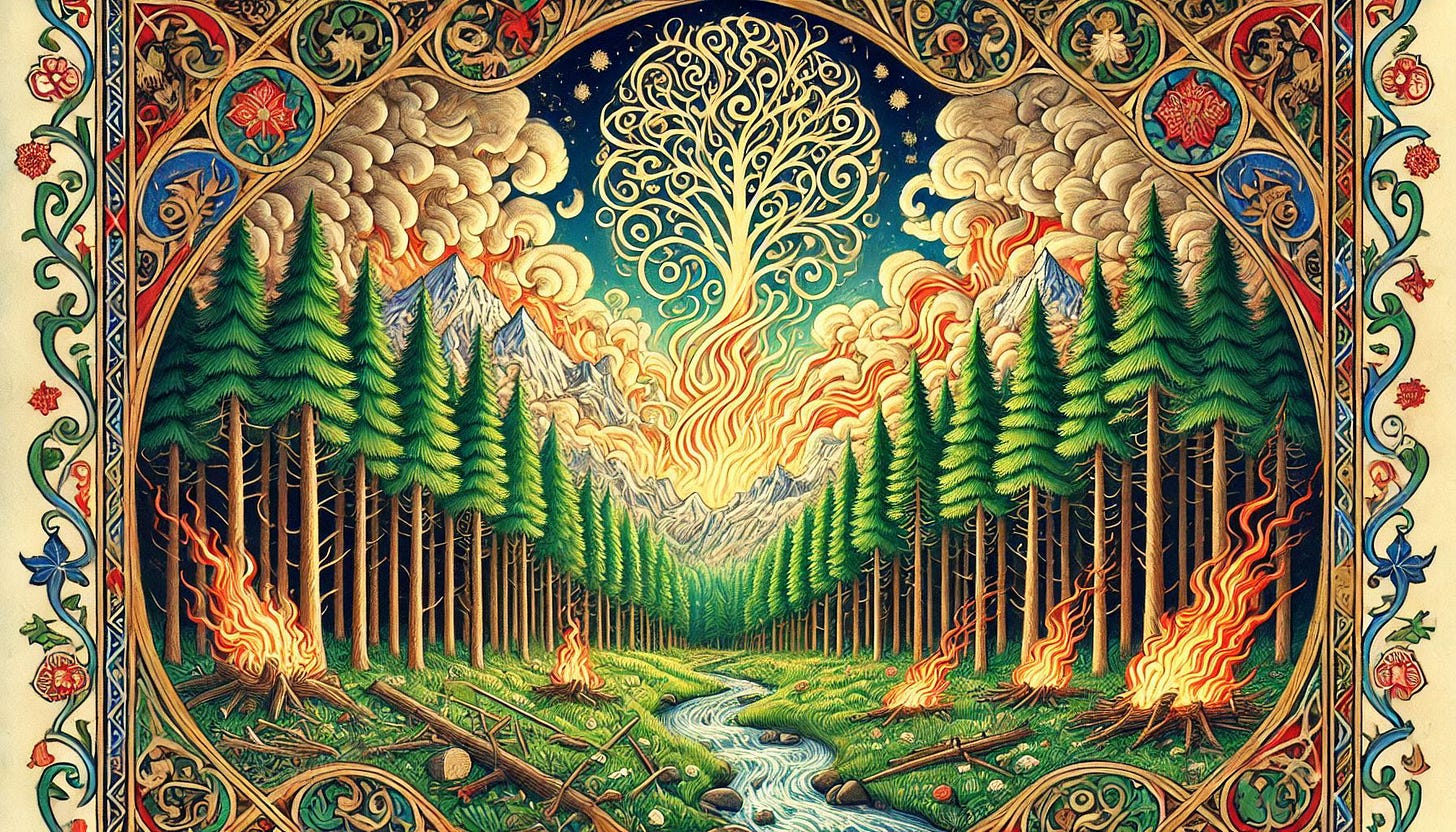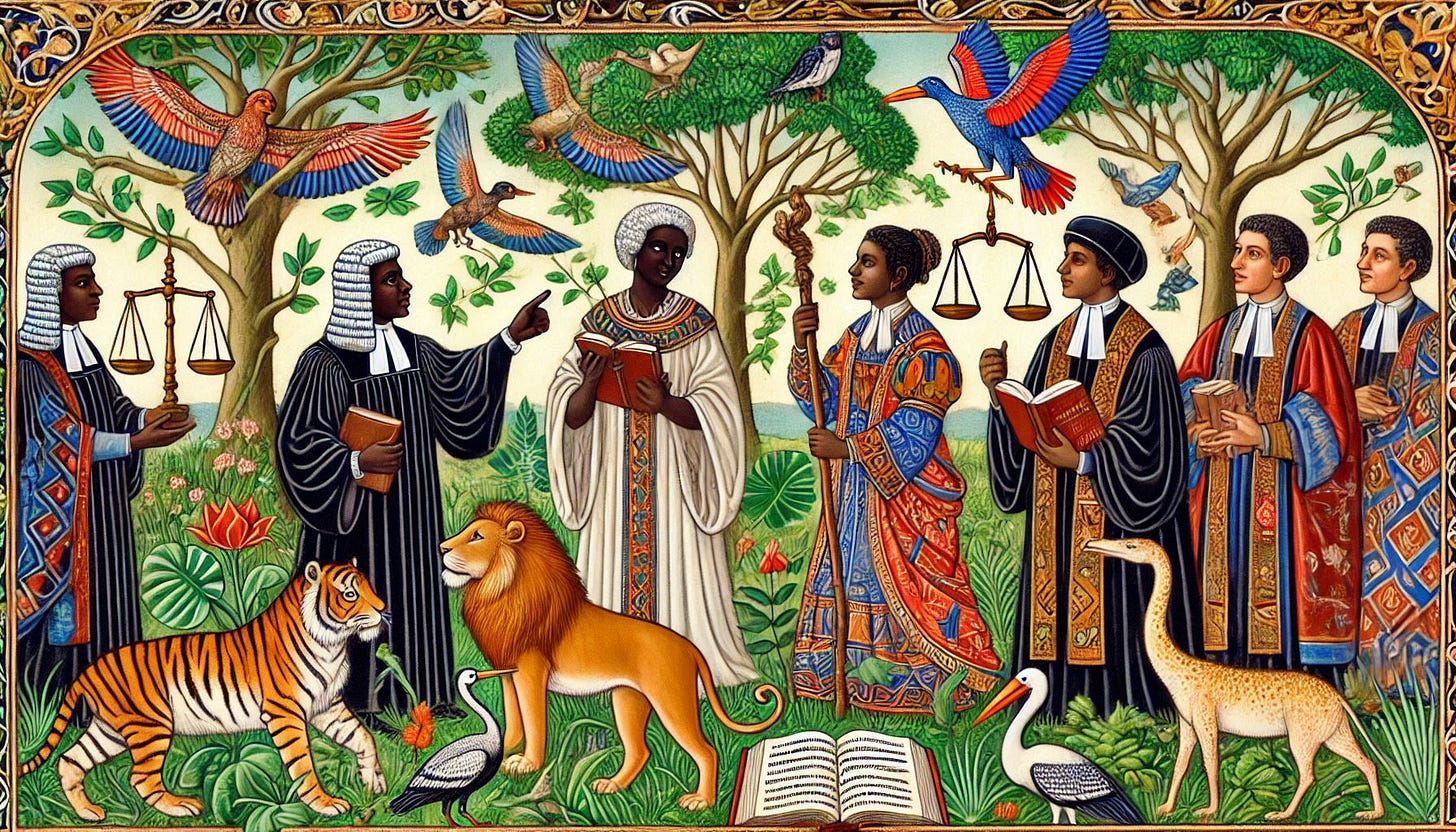Make nature artificial again
Slow the rise of global temperatures — and global absolutism
The pre-contact forests of North America were not natural, we know now, but were as artificial as an English garden. However, the people responsible for these artificial forests changed over centuries of English settler colonialism.
Who made widely-spaced American forests dense?
The first forests seen by the English even looked something like English gardens. Seventeenth-century Europeans in what’s now Ohio, Rhode Island, and Virginia marveled at how widely spaced the forests' trees grew. Settlers in Ohio would drive carriages through the forests without felling a tree. These Europeans didn't know the cause: almost every Native American nation across the continent had been regularly burning forests for thousands of years.
Two hundred years after the first English settlements, however, settlers often found what we associate with primeval forests. Nineteenth-century settlers often described "woodland unsullied by human presence," as science journalist Charles C. Mann puts it. They found it tough to walk through the dense thickets, much less to drive carriages through them.
But the indigenous peoples didn't cause the forests' condition this time. Instead, the later and much denser North American forests were, in a sense, curated by the settlers themselves. Their diseases and their forced removal of indigenous peoples had banished the caretakers who had managed the forests for millennia. In a social application of Heisenberg's Uncertainty Principle, the settlers' act of settling created their own sylvan vistas—or lack of vistas.
We destroy nature by carving out the artificial
We long for the natural, but we destroy the natural by juxtaposing it with the artificial. Our Eurocentric view of humanity as separate from nature, usually as higher than nature, feeds this false dichotomy. Indigenous peoples, by contrast, situate humanity roughly in the middle of any hierarchy of life, Vine Deloria, Jr. points out. Indigenous cultures live with other species as relatives. We and our inter-species relatives are better off when we interact with one another respectfully and take care of one another.
We tire of artifacts, of cigarette butts we find strewn in our national parks. We certainly don't wish to hear that the parks themselves are artifacts. But to create some of the earlier Western parks, the National Park Service (NPS) displaced the indigenous peoples who lived there. The NPS's vision of nature as separate from people contributed to this displacement, as Professor Jessica Hernandez explains:
National parks became places where humans could enjoy the beauty and some recreational activities, but national parks were not meant to become places where humans could also contribute to the healing of these landscapes.
Conservation shares modernity’s false binary between humanity and nature.
The natural/artificial divorce: a modern origin story
Modernity began when we began to despise the artificial. The etymology of “artifice” suggests the shift. The Oxford English Dictionary’s five oldest definitions of “artifice” involve skill or workmanship and carry positive connotations. Only the most modern—and now the only common—definition of “artifice” involves deceit.
History textbooks often mark the Middle Ages' end around 1500, eight years after Columbus brought "first contact" with its rapacity and disease to the Western Hemisphere. But for a demarcation between medieval and modern I prefer something later—November 10, 1608, a year after the English first settled at Jamestown. The eponymous king on that date met with his realm's judges to seek their assent to his plan to become a judge himself. James's famous dispute with his Chief Justice that day over the plan focused on whether judicial reasoning is natural or artificial.
The king reasoned that "he and others had reason, as well as the Judges," according to Edward Coke, the Chief Justice of Common Pleas who ventured to spar with the king. Coke responded to James by acknowledging the king's "great endowments of nature," but he pointed out that judges decide cases based on what he called "artificial reason"—that is, on the judges' recourse to their long study of England's slowly evolving common law. But the king found Coke's position treasonous since it implied that the king himself was under law.
The common law as a well-tended forest of artificial reason
The common law is a well-tended forest of judicial decisions that date back, as Coke would have it, to the days of legendary King Arthur. Reporters collect the cases, and hornbooks bring order to them. These dusty works allow lawyers and judges to discover precedents, which contain "immemorial" fundamental laws applicable to the case at bar. This artificial legal reasoning process has political consequences. As Professor James R. Stoner points out, Coke's jurisprudence begins by asking, "first and foremost, what is law? — not, who rules?"
Similarly, the indigenous approach to Turtle Island begins by asking, "Who are people within the natural world?" — not, "Who rules?"
Modernity began, one might say, when the Western world began to deny its own artifice. To be "pure," the modern assumption goes, neither law nor nature needs tending. As a result, both law and nature have become humanity’s playthings. Global absolutism rises with global temperatures.
Epilogue: Coke reports that he countered the king's accusation of treason by quoting Braxton, the great English jurist of the Middle Ages: "The king ought to be under no man, but under God and the law." Another witness to the confrontation, however, tells us that Coke, trembling, "fell flatt on all fower" before James and begged his forgiveness. But one way or the other, Coke carried the day, keeping kings from ascending the bench. James, however, went on to become England's first absolute monarch—itself a modern concept.
Images by Microsoft Image Creator.
Notes and reading:
1491: New Revelations of the Americas Before Columbus — Charles C. Mann. Mann covers the first European impressions of North American forests on pages 283-86, and he covers the later American impressions of the same forests on page 371: "By 1800 the hemisphere was thick with artificial wilderness. If 'forest primeval' means woodland unsullied by the human presence . . . there was much more of it in the nineteenth century than in the seventeenth."
Fresh Banana Leaves: Healing Indigenous Landscapes Through Indigenous Science — Jessica Hernandez. The above block quote is found on page 79.
The Late Middle Ages, a "Great Courses" audiobook by Philip Daileader. Professor Daileader's last lecture in the course challenges the common demarcation between the Middle Ages and Modernity as being the year 1500. Admittedly, he doesn't go with my November 10, 1608; he prefers the onset of the French Revolution in 1789.
"The Coming of the People" and "Reflection and Revelation: Knowing Land, Places and Ourselves," essays by Vine Deloria, Jr., anthologized in For This Land: Writings on Religion in America. Deloria was a theologian, historian, and Native American activist. Both essays refer to humanity's place roughly in the middle of the hierarchies of creation developed by many of Turtle Island's nations (pages 237 and 258).
Common Law and Liberal Theory: Coke, Hobbes, and the Origins of American Constitutionalism — James R. Stoner, Jr. Professor Stoner argues that "the spirit of common law includes a way of thinking about political liberty" and that the American founders, who were steeped in the English common law tradition, were influenced by that tradition as much as by liberal philosophers in founding the American republic. Stoner's account and analysis of the argument between Sir Edward Coke and King James I is on pages 62-65.
Oxford English Dictionary, s.v. “artifice (n.), sense 6.b,” September 2024, https://doi.org/10.1093/OED/2764205825.
Crown Under Law: Richard Hooker, John Locke, and the Ascent of Modern Constitutionalism — Alexander S. Rosenthal. Professor Rosenthal battles the modern misconception that absolute monarchy isn't a modern phenomenon. "The new power of kings made an absolutist system a practical possibility in the early modern period. . . . In the sixteenth century, constitutionalism emerged not as a reaction to medieval theory and practice, but as an effort to preserve elements of the medieval tradition from the new challenge posed by ascendant royal power" (page 89).






Another thoughtful essay Bryce. I am compelled by the idea of seeing ourselves in the middle of the hierarchy rather than on top. That fits with my experience of living on the Maine coast, where nature is more uncontrollable, and must be taken seriously. Also, the subtle dangers of searching for "pure nature." Romanticism was a necessary reaction to rationalism, but has also contributed to excessive individualism as we all search for our own personal truth rather than a shared truth. Thanks for the footnotes as well.
As always, Bryce brings to mind as much good thought as he shares. Here, among other gems: Bryce writes, "to be 'pure,' the modern assumption goes, neither law nor nature needs tending. As a result, both law and nature have become humanity’s playthings." This brings to mind (1) Molière (17th c.): "It takes a lot of work to be natural." (2) Goethe: "One must learn nature by heart to appear natural." And, (3) True beauty requires effort and kindness - Audrey Hepburn loved a poem that was read at her funeral, attributed to her but actually written by an American humorist (apparently, she started quoting it when asked for "beauty tips"): "For attractive lips, speak words of kindness. For lovely eyes, seek out the good in people. For a slim figure, share your food with the hungry. For beautiful hair, let a child run his fingers through it once a day. For poise, walk with the knowledge you'll never walk alone." Beauty is not naturally pure; like purity it takes doing. - Thanks again, Bryce!